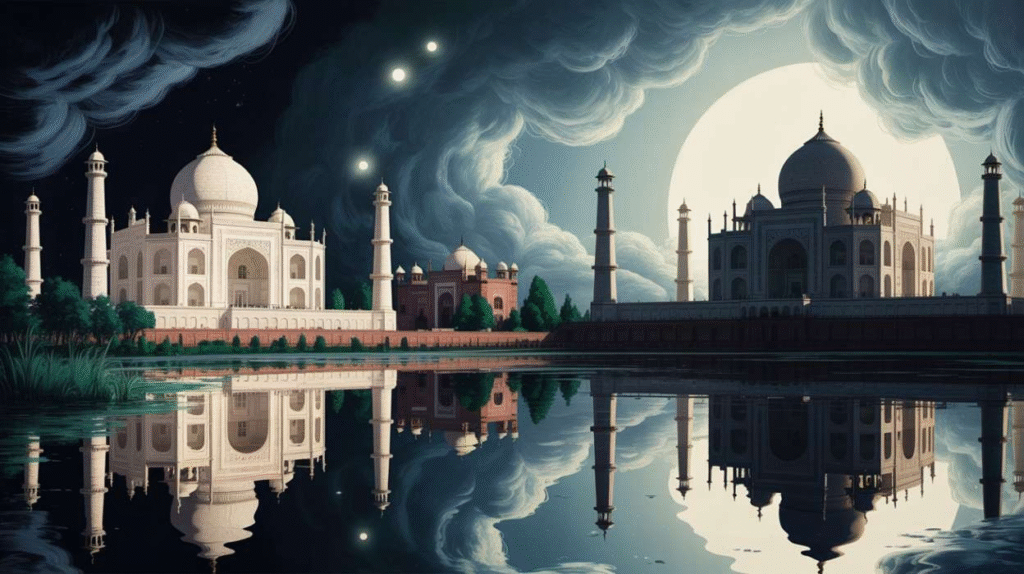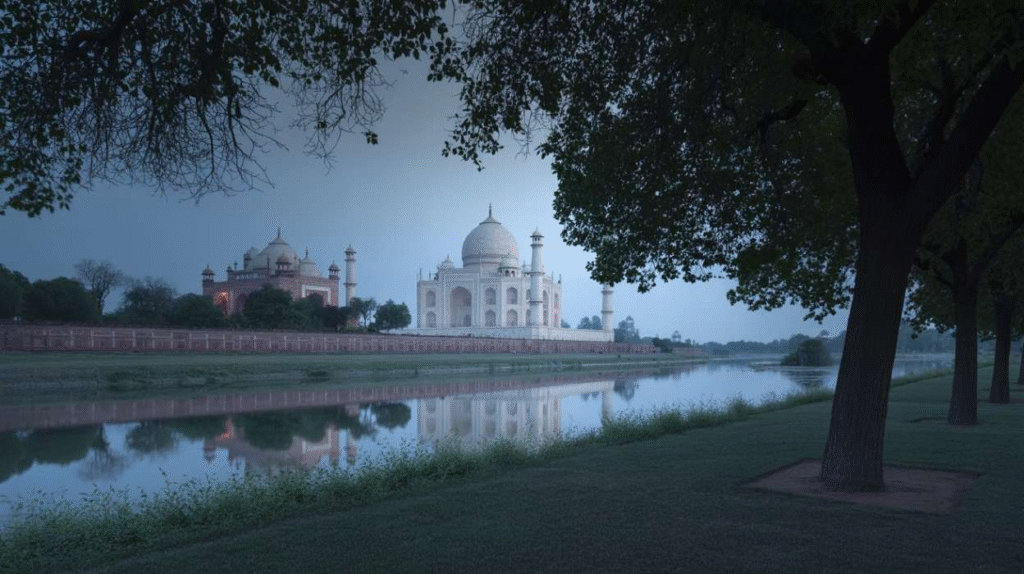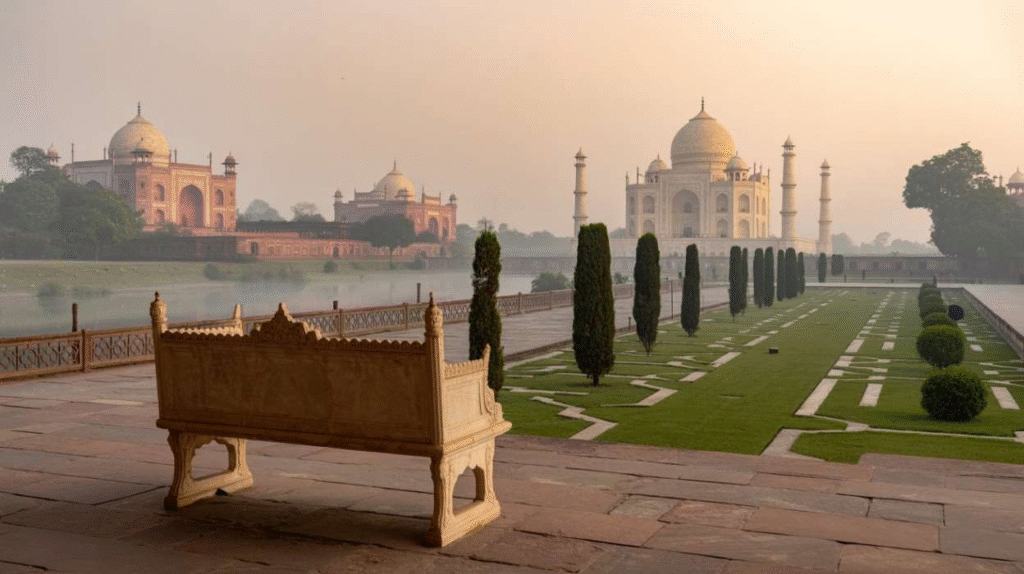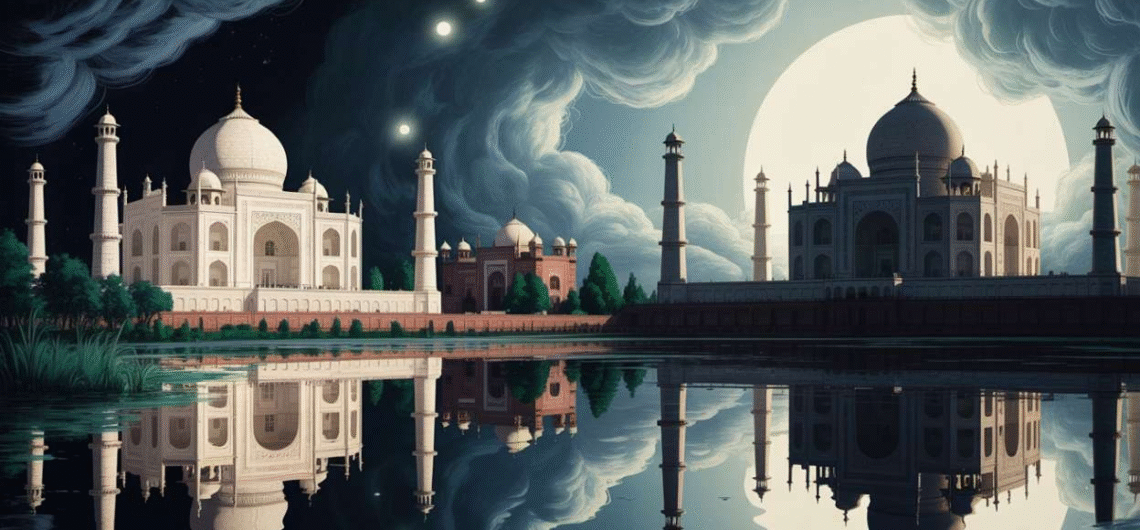Few monuments in the world captivate the imagination as deeply as the Taj Mahal. This breathtaking white marble mausoleum, nestled on the banks of the Yamuna River in Agra, India, is an enduring symbol of love and architecture. However, beyond its pristine beauty lies a mysterious legend that has fascinated travelers for centuries—the legend of the Black Taj Mahal. Could there really be a twin monument made of black marble mirroring the Taj Mahal across the river? The Black Taj Mahal story has excited imaginations worldwide, blending romance, ambition, and myth. This blog journeys through the Black Taj Mahal history, exploring the legend, archaeological evidence, expert opinions, and how travelers can still experience this intriguing mystery today.

The Black Taj Mahal Story: Shah Jahan’s Dream of a Black Marble Mausoleum
Legend says that Mughal Emperor Shah Jahan, in his immense love and grief for his wife Mumtaz Mahal, planned a magnificent mausoleum made entirely of black marble across the Yamuna River. The Black Taj Mahal in India would serve as his own tomb, positioned exactly opposite the gleaming white Taj Mahal—a perfect twin symbolizing eternal togetherness in death.
The earliest Western account comes from Jean-Baptiste Tavernier, a French gem merchant and traveler who visited Agra in 1665. His writings sparked the legend by mentioning Shah Jahan’s ambitious plan to build a black marble mausoleum but also described how the project was halted when Shah Jahan was overthrown and imprisoned by his son, Aurangzeb. The story includes dramatic elements—a bridge connecting the two structures and a fierce family coup ending this dream.
This romantic and tragic tale has endured because it fits so perfectly with Shah Jahan’s reputation for architectural grandeur and deep love for Mumtaz Mahal. Yet, the story remained part history, part folklore for generations.
Black Taj Mahal History & Archaeological Findings at Mehtab Bagh
The legendary Black Taj Mahal is said to have been planned on the site known as Mehtab Bagh—the Moonlight Garden—on the northern bank of the Yamuna River facing the Taj Mahal. Mehtab Bagh was originally a Mughal pleasure garden founded by Emperor Babur, designed to offer spectacular views of the Taj Mahal.
Archaeological excavations in the late 19th century by A.C.L. Carlleyle revealed remnants of blackened stones, spurring speculation about a black marble structure. Further investigations by the Archaeological Survey of India in the 1990s and 2000s uncovered gardens, fountains, and a large octagonal water tank aligned symmetrically with the Taj Mahal. Some stones originally thought to be black marble were later identified as white marble discolored by moss and pollution over centuries.
Extensive excavations have not revealed any definitive foundation or remains of a black mausoleum at Mehtab Bagh. Instead, the findings support the view that Mehtab Bagh was a classic Mughal garden meant for moonlit reflections of the Taj Mahal rather than the site of a black marble tomb.
Why Historians Consider the Black Taj Mahal a Myth
Despite the allure, historians and archaeologists today largely agree that the Black Taj Mahal in Agra never existed as a physical monument. Several reasons contribute to this view:
- Lack of Concrete Archaeological Evidence: No verified foundation, walls, or structural remains characteristic of a mausoleum have been discovered at Mehtab Bagh or elsewhere.
- Historical Timeline Constraints: Shah Jahan completed the Taj Mahal in 1653, but was imprisoned just five years later in 1658 following his son Aurangzeb’s coup. The scale of work needed to start even half of such a grand plan seems improbable in that timeframe.
- Aurangzeb’s Role: Historical records show Aurangzeb’s austerity and opposition to his father’s extravagant projects, making it unlikely he would have permitted the Black Taj Mahal’s construction.
- Tavernier’s Accounts as Anecdotal: Tavernier’s writings, while valuable, are considered partly fanciful and not always historically accurate.
- Reflection Theory: Some scholars suggest the legend was born from seeing the Taj Mahal’s reflection in the calm, dark waters of the Yamuna at night, giving the illusion of a black twin.
The official Taj Mahal authorities recognize the legend but emphasize it remains a myth without historical proof.

Why the Legend of Black Taj Mahal Still Fascinates Travelers
The Black Taj Mahal legend enchants travelers because it adds an aura of mystery to an already magnificent site. It feeds on themes of love, loss, power struggles, and unfinished dreams—elements that weave perfectly into the romantic narrative of Shah Jahan and Mumtaz Mahal.
For international visitors, the possibility of a hidden or lost twin mausoleum makes the Taj Mahal experience even more intriguing. It invites contemplation beyond the visible structure—in whispers of what might have been. The story evokes emotions and sparks imagination, forging a deeper connection to the monument and its history.
The shadowy romance of the Black Taj Mahal encourages visitors to search for clues, visit Mehtab Bagh, and see the Taj Mahal in a new light—literally and figuratively. This allure ensures the legend remains immortal alongside the white marble beauty.
Experiencing the Mystery Today: Travel Tips for Visiting Mehtab Bagh
To truly appreciate the Black Taj Mahal story and its mystery, visiting Mehtab Bagh is essential. This tranquil garden is located just across the Yamuna River from the Taj Mahal and offers breathtaking views.
Here’s what travelers can expect:
- Best Viewpoint: Mehtab Bagh is the ideal spot to view the Taj Mahal’s full facade and its reflection in the water pools, especially magical during sunrise and moonlit nights.
- Serene Garden Atmosphere: Unlike the crowded Taj Mahal grounds, Mehtab Bagh provides a peaceful setting to absorb the beauty and imagine the lost Black Taj Mahal.
- Accessibility: The garden is open daily, with evening hours available for a special viewing experience.
- Guided Tours: Many Taj Mahal tours include Mehtab Bagh and tales of the Black Taj Mahal legend, enriching the visit with expert storytelling.
Walking through Mehtab Bagh, visitors can sense history wrapped in mystery—a perfect blend of facts and folklore that makes Agra’s heritage unique.

Black Taj Mahal Mysteries: Your Top 5 Questions Solved
1. Is the Black Taj Mahal real or just a myth?
The Black Taj Mahal is considered a myth by historians and archaeologists today. While French traveler Jean-Baptiste Tavernier mentioned Shah Jahan’s plan for a black marble mausoleum in 1665, extensive archaeological excavations at Mehtab Bagh have found no concrete evidence of such a structure. What appeared to be blackened stones were later identified as white marble discolored by moss and pollution over centuries.
2. Where was the Black Taj Mahal supposed to be built?
According to legend, the Black Taj Mahal was planned to be built at Mehtab Bagh (Moonlight Garden) on the northern bank of the Yamuna River, directly opposite the white Taj Mahal. This Mughal pleasure garden, originally founded by Emperor Babur, offers spectacular views of the Taj Mahal and remains a popular tourist destination today.
3. Why didn’t Shah Jahan complete the Black Taj Mahal project?
Historical accounts suggest that Shah Jahan’s ambitious black marble mausoleum project was halted when his son Aurangzeb overthrew and imprisoned him in 1658. The Taj Mahal was completed in 1653, leaving only five years for any potential black tomb construction. Aurangzeb’s known austerity and opposition to extravagant projects make it unlikely he would have permitted such construction.
4. What archaeological evidence exists for the Black Taj Mahal?
Archaeological excavations by A.C.L. Carlleyle in the late 19th century and later by the Archaeological Survey of India revealed garden layouts, fountains, and an octagonal water tank at Mehtab Bagh. However, no foundations, walls, or structural remains of a mausoleum have been discovered. The site shows evidence of being a classic Mughal garden rather than a tomb complex.
5. Can visitors see the Black Taj Mahal site today?
Yes! Visitors can explore Mehtab Bagh, where the legendary Black Taj Mahal was supposed to be built. This tranquil garden offers the best views of the Taj Mahal’s reflection in water, especially magical during sunrise and moonlit nights. Many Taj Mahal tours include Mehtab Bagh visits with storytelling about the Black Taj Mahal legend, making it a must-visit spot for mystery enthusiasts.
Conclusion: Romance and Mystery Across the Yamuna
The Black Taj Mahal remains one of the most captivating legends surrounding India’s iconic white marble monument. While historians and archaeologists dismiss it as myth, the emotional and cultural power of this story continues to draw travelers worldwide.
Shah Jahan’s dream of a black marble twin mausoleum symbolizes love, loss, and the mysteries history refuses to reveal fully. Visitors to Agra today can touch this legend by standing in Mehtab Bagh, gazing across the Yamuna, and imagining the moonlight reflecting a monument that might have been.
Those enchanted by romance, mystery, and Mughal grandeur should explore Taj Mahal tours in India that include this magical garden and the tales woven around the Black Taj Mahal. It’s a journey into the heart of love’s enduring legacy—one where every shadow and light tells a tale worth discovering.


Comments